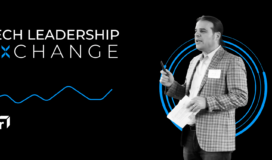Navigating the Complexities of Technology Leadership in a Digital-First World
Insights from SPR’s Tech Leadership Exchange
The pace of technological change is relentless, and today’s technology leaders are expected to navigate a labyrinth of challenges that range from integrating artificial intelligence (AI) to modernizing legacy systems. Digital transformation is no longer optional—it is essential for organizations seeking to remain competitive. However, the process of transitioning to a modern digital framework can be fraught with risks, especially when legacy systems, technical debt, and employee resistance are involved.
At SPR’s 2024 Tech Leadership Exchange, brought together about 30 tech leaders to share insights on these challenges, providing a roadmap for leaders tasked with driving innovation in the face of operational constraints.
Drawing from the event’s discussions, along with real-time polling data gathered from attendees, this article explores key concerns of technology leaders and offers strategic guidance for tackling these issues head-on.
1. Overcoming Legacy System Challenges
Digital transformation is a key priority for many organizations, yet modernizing legacy systems remains a significant hurdle. One speaker from a multinational retail corporation discussed the complexities of adapting consumer-facing systems to meet the unique demands of business-to-business (B2B) transactions. Their infrastructure, initially optimized for consumer operations, needed a complete overhaul to handle bulk ordering, client account management, and business-specific services.
Polling data from the event revealed that 67% of organizations are still in the process of modernizing their legacy systems, with 31% reporting that technical debt significantly hinders their ability to innovate. Legacy systems often include outdated tools and processes that can be difficult to integrate with modern technologies, slowing down innovation and creating operational bottlenecks.
ACTION ITEM: Leverage Existing Infrastructure
Rather than attempting to rebuild everything from scratch, organizations should leverage existing infrastructure, introducing incremental updates to support new business models. One retail company enhanced its supply chain and logistics capabilities to meet B2B demands without sacrificing its core B2C operations. “We didn’t need to rebuild everything from scratch,” said Byron Uytiepo from the retail company. “Instead, we leveraged the ‘highways’ we already had, such as our existing supply chain, and focused on building ‘gravel roads’ where necessary. These were the smaller, targeted improvements that filled the gaps without overhauling the entire system.”
Additionally, organizations must adopt a “scrappy” mindset when getting started. It’s key to have face-to-face interactions with customers – get out in the field, ask direct questions, and glean insights that shape product and service offerings. This hands-on approach ensures that leaders understand the customer experience in real time, enabling them to make informed decisions when transforming legacy systems.
“We didn’t need to build everything from scratch; we took advantage of what was already there and filled gaps where needed.”

“We didn’t need to build everything from scratch; we took advantage of what was already there and filled gaps where needed.”
Byron Uytiepo, Head of Product, Fortune 5 Retailer
2. AI Adoption: Simple, Better
Artificial intelligence (AI) is becoming central to many organizations’ digital strategies, but AI implementation presents its own challenges. A medical consultancy firm shared how they used AI to streamline routine tasks, such as generating reports that contain medical data. By shifting employees from repetitive tasks to quality control, the company achieved greater accuracy and efficiency.
Polling data revealed that 44% of respondents are actively exploring AI adoption, yet 63% struggle with finding the necessary talent to implement AI solutions. This highlights a broader issue: while AI promises to revolutionize business processes, its implementation often requires significant expertise and careful planning.
ACTION ITEM: Adopt a “Crawl-Walk-Run” Approach to AI
Organizations should start small with AI by identifying specific use cases where the technology can deliver immediate value. For instance, the medical consultancy firm used AI to streamline one key aspect of their service—report generation—which allowed them to gain early wins and build organizational confidence in AI. This “crawl” phase helped generate momentum that carried over into larger-scale AI applications down the line.
Tech leaders should focus on manageable AI projects to test their impact and scalability before fully committing to enterprise-wide implementations. This ensures that the transition is smooth, and challenges such as integration with existing systems or token limits can be addressed without overwhelming the organization.
To manage the fear of AI replacing human jobs, leaders must also make sure employees see themselves as part of creating a better future. Communicate clearly around AI’s role as an augmenting tool rather than a replacement. By involving employees in AI initiatives and explaining how it will enhance their roles, leaders can reduce resistance to AI and foster collaboration.
“AI is about helping people do things better, not replacing them.”

“AI is about helping people do things better, not replacing them.”
3. The People Side of Transformation: Managing Change
The technical side of digital transformation often dominates the conversation, but it’s the human element that often presents the biggest challenges. At a logistics and supply chain firm, for example, digital transformation is as much about change management as it is about technology. When this company sought to modernize its operations, they faced significant resistance from employees who were hesitant to adopt new systems.
This was a top challenge for poll respondents as well, with 23% citing resistance to change as one of the biggest challenges in modernizing legacy systems. Whether due to fear of job loss or simply a reluctance to adopt new tools, this resistance can derail even the most well-planned technology initiatives.
ACTION ITEM: Build a Trustworthy Team and Over-Communicate
To overcome resistance, leaders must prioritize trust-building within their teams. The logistics firm highlighted the importance of having a trusted core team that can guide the organization through uncertainty. By bringing decision-makers—those who would be using the new tools—into the fold, they were able to build trust and buy-in incrementally.
“We learned to over-communicate and under-explain,” said the logistics leader. “Change is scary, and people don’t like surprises. To avoid surprises, we established a steady rhythm of communication.”
Over-communication was key to their success; regular updates and simplified messaging helped keep everyone aligned, even in a complex, global organization where English was not always the primary language.
Additionally, consistent communication is essential: leaders should over-communicate to keep employees informed and simplify their messaging to avoid overwhelming staff with technical details.
Employees are more likely to embrace change when they understand the broader goals behind it. By simplifying the message and keeping the lines of communication open, leaders can alleviate fears and keep teams focused on the bigger picture.
“Change is the one constant. What makes it easier is following those you trust.”

“Change is the one constant. What makes it easier is following those you trust.”
Nikolai Wasielewski, Director, Logistics and Supply Chain Company
4. Building Agility: Incremental Decision-Making
Agility is critical for organizations that must quickly respond to market changes and technological advances. One organization adopted an incremental decision-making framework, enabling them to make small, manageable changes and adjust based on feedback. This agile approach allowed them to innovate rapidly without overwhelming their teams.
Polling data showed that 41% of organizations frequently update their product offerings based on customer feedback. This reflects a broader shift toward agile methodologies and product management, where organizations continuously iterate and evolve based on real-time insights from customers and market trends.
Key Strategic Insight: Pilot, Iterate, Scale
To build agility into their transformation processes, organizations should adopt a pilot-iterate-scale approach. By testing new ideas on a small scale, gathering feedback, and refining the approach, leaders can ensure they are adapting to customer needs while minimizing risk. Once a pilot is successful, the initiative can be scaled to the broader organization, ensuring that each step includes change management considerations to support adoption throughout as a part of the full rollout.
Agility is especially important in industries where technology and customer expectations are constantly evolving. The ability to quickly pivot based on feedback can give companies a competitive advantage in fast-paced markets.


5. Customer-Centric Transformation
One notable theme is the emphasis on understanding and responding to customer needs. A resounding 78% of poll respondents stated that while they have a good understanding of their customers’ needs, they are still refining their knowledge. And 47% mentioned that they update their products occasionally based on feedback. This shows a shift in focus toward becoming more customer-centric, even in industries not traditionally considered as customer-driven, such as logistics or B2B services.
One company sees the importance of continuously evolving their technology platform to meet customer expectations. For example, they conducted extensive customer interviews and used data analytics to ensure that their digital transformation aligned with customer needs.
ACTION ITEM: Include the Customer Experience in Technology Decisions
Technology leaders should integrate customer feedback loops into their innovation process. Whether using direct feedback or analyzing customer behavior through data, keeping the end user at the center of technology decisions ensures that investments drive real value. As customers’ expectations continue to evolve, having a flexible, feedback-driven process is crucial for staying relevant. Plus, organizations should re-examine existing data to glean new insights. There is value in looking at data differently: sometimes, the story a company needs to move forward is already in the data, but it requires creative thinking and a new perspective to unlock hidden patterns or opportunities. By analyzing existing data through a different lens, companies can discover untapped areas for innovation, optimize processes, or even identify emerging customer needs that weren’t initially apparent. This approach not only improves decision-making but also ensures that technology investments are aligned with future growth and evolving market demands.
6. Bridging the Skills Gap
The skills gap—particularly in areas like AI, cloud computing, and data analytics—was a recurring theme at the event, with 63% of respondents stating that a lack of skilled talent was a major obstacle to AI adoption. As digital transformation accelerates, the gap between the skills organizations need and the talent available in the market continues to widen. One organization addressed this challenge by investing in upskilling employees, even going as far as retraining business stakeholders to be more adept with AI tools. This internal upskilling allowed employees to better understand and trust AI rather than fear job displacement.
ACTION ITEM: Invest in Continuous Learning and Upskilling
To address the skills gap, organizations should prioritize continuous learning. This could include formal training programs, partnerships with educational institutions, or incorporating employees into outside-led initiatives in a hybrid model. This supports learning throughout the duration of the project and helps the team maintain, train and expand the solution after the initial initiative. Upskilling employees ensures that organizations can fully harness the potential of advanced technologies while retaining talent and fostering loyalty.


7. Protecting Digital Assets in a Cloud-First World
As organizations shift to cloud-based infrastructures and adopt advanced technologies like AI, cybersecurity becomes a paramount concern. One speaker highlighted how their company faced increasing cyber threats, requiring them to rethink their entire approach to securing digital assets. Moving to the cloud introduced new challenges, such as securing remote access and ensuring compliance with data protection laws across multiple regions.
This is a growing concern, with 69% of poll respondents citing data privacy and security as their primary challenge in adopting new technologies. As organizations become more dependent on digital solutions, the stakes for protecting sensitive data rise considerably.
ACTION ITEM: Embed Security into Every Stage of Digital Transformation
Organizations must build security by design into their digital transformation initiatives, ensuring that cybersecurity is a fundamental part of the planning and implementation process. This includes adopting zero-trust architectures, performing regular security audits, and implementing strong encryption protocols. Continuous monitoring and rapid incident response mechanisms are also crucial to identify potential vulnerabilities before they escalate.
Leaders should also consider forming strategic partnerships with cloud and cybersecurity providers to strengthen their security posture, enabling them to tap into expert resources without overburdening internal teams.
Conclusion: Leadership for the Future—Embracing Change and Continuous Innovation
Today’s technology leaders are faced with a rapidly changing digital landscape, requiring a forward-thinking mindset to navigate constant waves of transformation. As emphasized at SPR’s Tech Leadership Exchange, change is the only constant, and those prepared to embrace it will turn challenges into opportunities for innovation.
The ability to cultivate adaptable, collaborative teams is key in responding to technological advances. Building a culture of continuous learning, experimentation, and calculated risk-taking is essential for keeping pace with fast-evolving industries. Leaders must invest in development programs that equip teams with the skills needed to thrive amidst these changes.
A balance between pragmatism and innovation will enable organizations to modernize legacy systems, adopt AI, and address cybersecurity risks—all while remaining agile. By fostering trust, staying close to customers, and continuously upskilling employees, leaders can ensure their organizations not only survive but thrive in this new era of digital transformation.
Ultimately, clear communication, strategic decision-making, and a commitment to continuous innovation are what will position today’s leaders to successfully navigate the complexities of tomorrow’s digital world.

